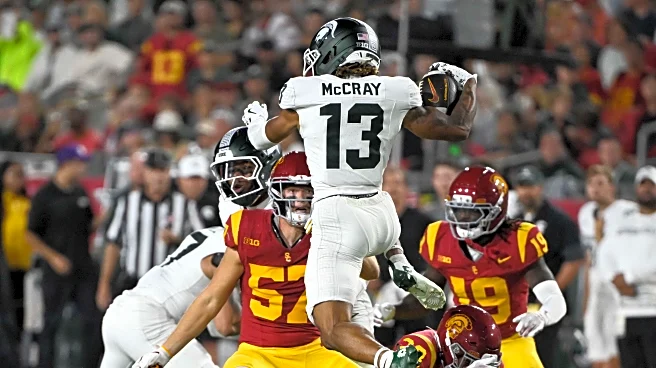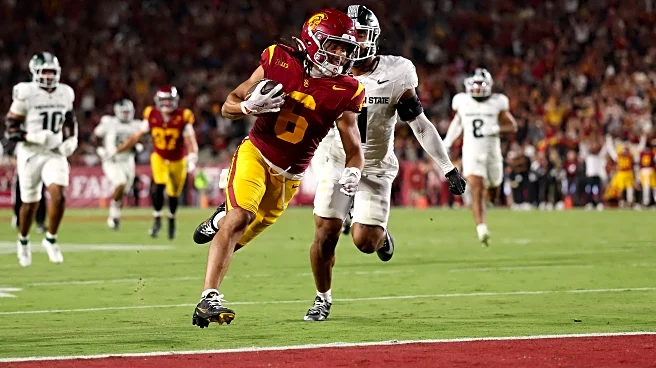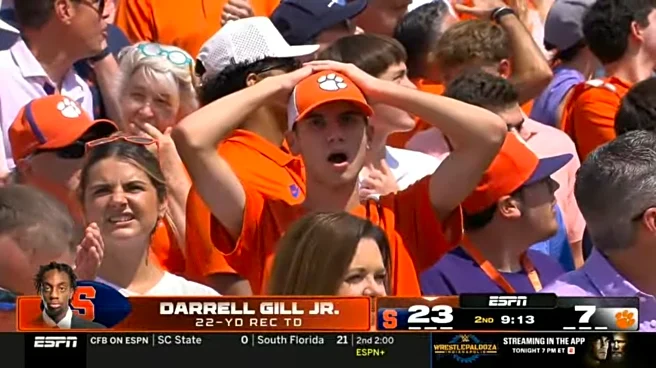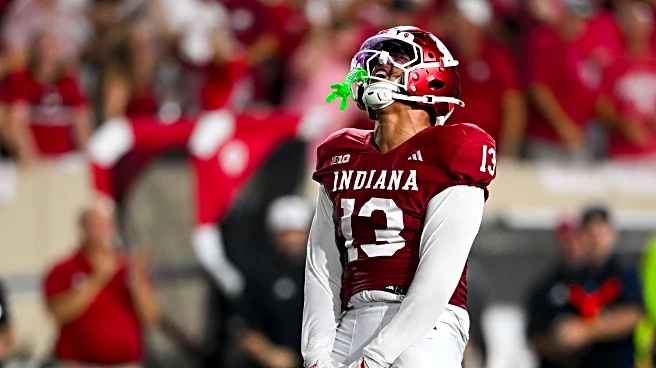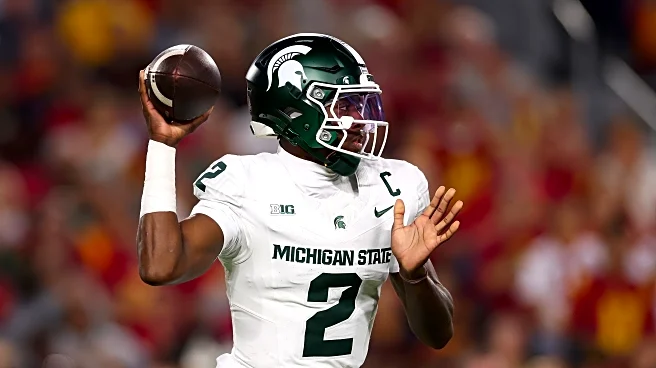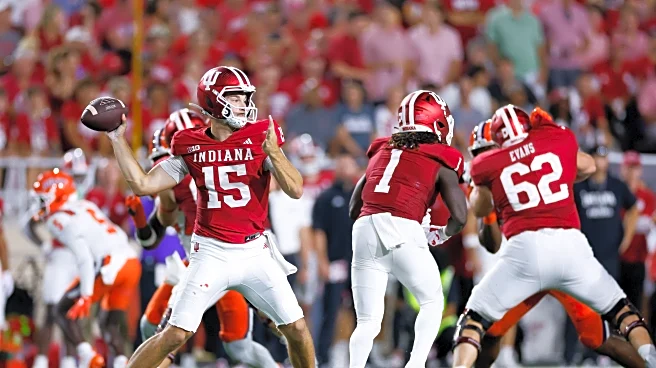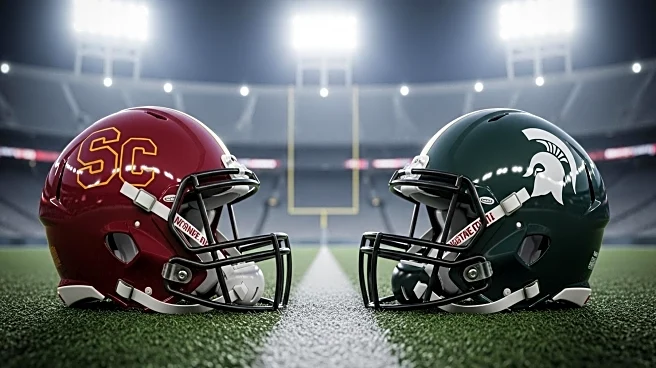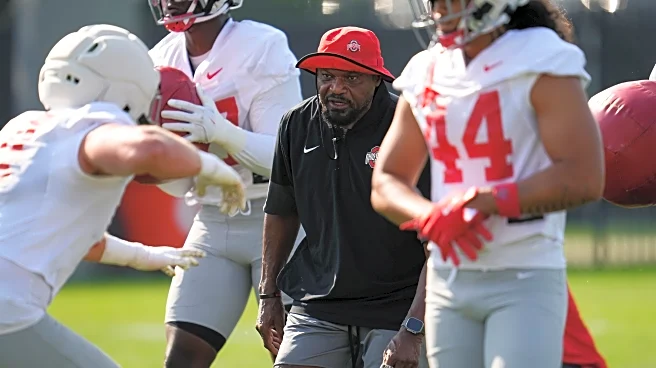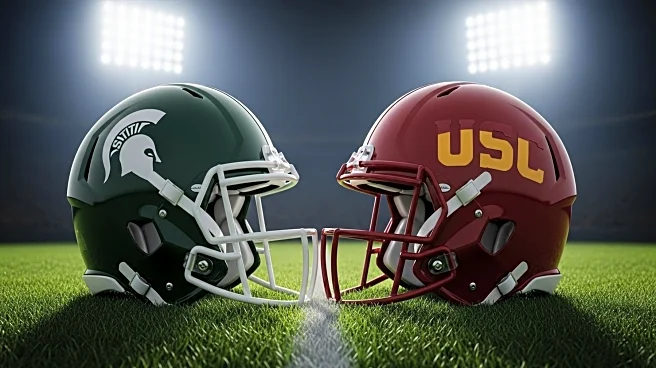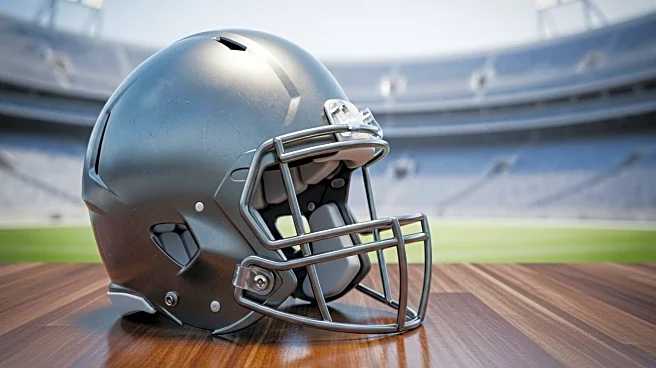Welcome back to the film room. This past weekend, our Spartans made the trip out to Los Angeles to take on Big Ten newcomer Southern Cal. Once Sunday came around, MSU returned to East Lansing with its formerly unblemished record now tarnished, several injuries to key players piling up, and lasting concerns about yet another disappointing loss in the Jonathan Smith era.
As the scoreboard in the LA Memorial Stadium hit double zeroes, a final of 45-31 displayed a fourteen point loss for Michigan State.
While the MSU offense continued to show promise, the defense, weakened by injuries, allowed Jaden Maiava and the Trojan attack put on a clinic in nearly every aspect. Before we get into the film of this late night affair, let’s take a minute to step back and compare talent on each of these rosters.
Watching State’s defense, battered by injuries, give up consistent chunk plays during this past game had me thinking: there is only so much that scheme can do. From a USC offensive perspective, it seemed that the Trojans were easily dominating the Spartans in terms of physicality, speed, and overall athleticism on relatively simple concepts from Head Coach Lincoln Riley. So I decided to take a deeper dig into the talent gap between these teams for this week’s write up…
The “Blue Chip Rating” is a statistic introduced in 2013, giving a simple percentage to sum up a team’s amount of 4 and 5 star recruits compared to lower rated acquisitions. Every single modern-era national champion has had a 50% or greater ratio, often exceeding 75%. For reference: last year’s Ohio State squad, with all of the 2024 Buckeye’s portal and recruiting spending, graded out at a staggering 90% rating. This season, CBS compiled a list of all the teams above that 50% benchmark, and the USC Trojans ranked in the top 10 with a BCR of 57%. A deeper dig is required to find Michigan State’s BCR, but according to sites like Punt and Rally, the 2025 Spartan roster grades out at just 14% blue chip recruits.
I am, by no means, arguing that recruiting stars mean everything. We all, as MSU fans, witnessed the magic that now Hall of Fame Coach Mark Dantonio was able to work with underrated, underrecruited 2 and 3 star players in the 2010s; consistently outperforming much more talented squads (on paper). But in today’s college football landscape, talent is as important as it has ever been. Transfers and NIL make former advantages like leadership, team-first mentalities, and player-to-player chemistry more scarce than ever; giving the edge to teams who are able to out-talent the other. This trend was evident Saturday night and Sunday morning in LA.
I am also not attempting to make excuses for the coaching staff. I remain thoroughly disappointed in the performances thus far of highly regarded Defensive Coordinator Joe Rossi and the rest of the defensive staff. With that being said, the situation MSU found itself in was nearly impossible. Beyond the aforementioned gap in talent between the two squads, State was faced with a ridiculously late night kickoff, a hostile road environment, and penalties/injuries robbing the Spartans of leaders (and some blue chip talent) in Jordan Hall, Nikai Martinez, Wayne Matthews, and Quindarius Dunnigan.
What am I trying to say? With all of this adversity facing Michigan State, being able to stay within a touchdown late in the second half, and cover the spread in a fourteen point loss speaks to the character and resilience of this team (mostly the offense). I understand all of the concerns, and I share many of them, as you will see later in this breakdown. But the sky is not falling. Before we take a look at the tape- ask yourself: would last year’s team, or even the 2023 squad, have kept fighting like the offense did, to make this a game late into the night on the West Coast?
Offense
Keeping with the theme of numbers; 31 points should be enough to win a football game on the road. 28 minutes of possession to USC’s 31, while not perfect, should be enough to win a football game. Over 100 rushing yards, 220 passing yards, and zero turnovers from an offense should, at the very least, keep a team in a close game. However, after only 4 games so far with this team, we know better. Brian Lindgren called a good game. Aidan Chiles was efficient, accurate, and elusive. Makhi Frazier ran hard, Chrishon McCray and Omari Kelly stepped up when the USC defense took away Nick Marsh for much of the game, and the tight ends were solid as usual. The offense had a good outing. But if the defense is going to continue to struggle as they have, the MSU offense is going to need to play great, if not near perfect to beat quality opponents like Southern Cal.
Let’s dive into the tape late in the second quarter. The Spartan’s first touchdown came on a big play to McCray, and here on third down, Chiles once again called upon number 13 in hopes of capping off a sustained drive with a TD to cut the defecit to 3 points. Here is the drawn-up version of the Red Zone verticals concept Coach Lindgren has dialed up:

Despite looking like a normal four verticals play, the bunched up alignment of the Spartan WRs adds some nuance. The “point man,” or top of the bunch, Omari Kelly, is tasked with crossing the field towards his landmark of the opposite hashmark. On the outside of the bunch, Nick Marsh has the middle vertical, looking to run relatively straight with the ability to bend towards the middle of the field if that is where he can find a lane to the QB. And McCray, lined up in the slot, will loop around both Kelly and Marsh and head towards the landmark of the numbers to the bottom of your screen. With three defenders all head-up and staring directly at the three MSU ball-catchers, Chiles likely diagnoses a man-to-man look pre-snap. This is reinforced by the defensive front, with a whopping seven Trojan defenders down on the line of scrimmage. USC is likely in some kind of a Red Zone man, heavy pressure look.

Wow. That’s a lot of lines. Bear with me here as we break down what is an advanced pressure from the SC defensive front seven. The middle two defenders, numbers 8 and 57, mimic the blitz before dropping back into zone coverage in the middle of the defense. This would likely have combated any crossing routes, had that been the MSU offensive playcall. The outside three defenders to the field all blitz, along with the two outside players toward the boundary.
This pressure is not only effective in confusing the Spartan OLine in terms of who to pick up, but it also renders Center Matt Gulbin and Right Tackle Conner Moore, MSU’s best graded offensive linemen, useless. The boundary blitzers, instead of facing interior offensive linemen, square up against TE Jack Velling and notoriously struggling pass protector Brandon Tullis. Watch below as the Spartan’s route combination works to free up McCray for a back shoulder ball, but pressure forces Aidan Chiles to rush his throw and just barely miss his target.

In the first three games of the year, Aidan Chiles was often able to evade various pass rushes and buy time, covering up a variety of mistakes from the offensive line. This time, the poor pass protection catches up to him, and the USC blitz contains him to the pocket and forces an inaccurate pass for Aidan’s first incompletion of the game. Just like we talked about last week, the offensive line was going to need to step up against a vastly talented Trojan defensive front. For the most part, I would argue that they were serviceable. However, creative pressures from USC were able to take advantage of weaker blockers like Velling and Tullis, and keep Chiles on the ropes, just enough to keep the MSU offense from making this game even more interesting.
And as we have harped on all season, Tullis is a serious liability in pass protection. Had he blocked the blitzing right side end for even a split second, Chiles would have been able to deliver a better ball, and who knows what happens after MSU cuts the lead to 3.
Now, to the second half. On the first play of MSU’s second possession, USC lines up in this defensive look to Michigan State’s “Ace Right” formation, with TE Masunas giving the offense six men up front, and McCray in the slot to the field. Put yourself in Brian Lindgren’s shoes. How do you think you would attempt to counter this defensive look?

If you answered some kind of quick-hitter passing to McCray in the slot, good guess. If you said take advantage of the soft edge to the boundary and run the ball left, give yourself a pat on the back, and maybe look into helping out coach your local youth or high school football team. That is exactly what Aidan Chiles does. While the playcall from the sideline is an inside zone run to the right, Chiles uses his savvy and pulls the ball for a QB keeper.

It’s simple math. Notice how if Chiles runs the ball himself, only one block has to win for it to be a successful play (Masunas’s, marked in red). If he gives the ball, all five of the other offensive linemen have to win their blocks (marked in black) and create a hole for the RB. In addition, Omari Kelly is running a quick out as an RPO, or run pass option for Chiles. This route in effect “blocks” the Trojan cornerback, taking him out of position to make a play on the ball, and opens a crease for Aidan to pick up 15 yards and a first down. This is a great example of the Spartan offense thinking smarter, not harder, to counter a more talented defense and get playmakers in the open field. Check it out below.

Next up, we are going to take a look at some good old fashioned Spartan run plays. Brian Lindgren’s offense is undoubtedly at its best when MSU can effectively mix run and pass plays, as evidenced by the often successful opening, scripted drives of games. In this game versus USC, the MSU offense began to struggle late in the first half when they became one dimensional. Pass rushers can pin their ears back and force Aidan Chiles out of the pocket, and defensive backs can take deeper drops without having to worry about their run support responsibilities. Early in the second half though, the Spartans found offensive success yet again. How? Through finally achieving a push up front in the run game.
The two best run plays in this game for Michigan State came consecutively. Below I have combined the back-to-back first down runs by Makhi Frazier into one clip; the first an exceptionally blocked outside zone run, followed by a potentially even better blocked inside zone.

Notice on each one the initial push by the offensive line. A big area of focus in our previous film room articles has been the need for the OLine to get off of double teams and work to the second level more effectively and consistently, and in each of these plays, they are successful in this sense. Watch the kick out blocks, seal blocks, downfield blocks by WRs, and position blocks by Tight Ends. Watch Frazier’s awesome cut in the second run. Watch Chiles cause defensive backs to hesitate with his RPO-fake in the first run, and his bootleg in the second. The run game can truly be a beautiful thing when set up and executed correctly.
While many MSU fans saw the balanced playcall in the second half as frustrating, citing a need to throw the ball downfield when put in a hole by the defense, I saw the second half playcall as a statement. Brian Lindgren knows what he wants his offense to look like, and the Spartan O is starting to click when it can mix run and pass. Instead of trying to have Chiles and company be players they are not, he stayed true to the initial game plan, which eventually did take a toll on the USC defense and even bring MSU within one score late. If and (hopefully) when the defense can start to hold up even a part of their end of the bargain, the Spartan offense will already have established an identity, be confident in their ablility to execute, and be ready to make winning plays, like we saw in the Boston College game.
Finally, to wrap up the offensive side of the ball, let’s end with a high note. I love this concept all around from Lindgren.

The creative take on pass protection is what makes the play; as the offensive line full-slides to their left, Chiles will take a quick look to Nick Marsh on a quick hitch to the boundary. However, he is taught to reset if Marsh is not open by maneuvering in the pocket to his right, where Velling will have stayed in for protection and sealed off the field side defensive end.
This “dash” protection has been a huge trend in all levels of football recently, with the aggressive slide of the line in one direction accompanied by Chiles looking that way baiting the field D-End into thinking it is a quick game throw. When Aidan resets, the defensive end is far enough upfield in pass rush where Jack Velling can kick him out, and buy QB1 enough time to unleash an absolute bomb of a throw to Omari Kelly.

Yes, Omari does a great job of using his speed to outrun his defender. But make no mistake. This is an NFL-level throw from Aidan Chiles. He rips this ball 55+ yards on the money, continuing the trend of his improving deep ball accuracy. We have a true talent on our hands in #2, and as he continues to improve in extending plays and making the players around him better, we can expect even more highlight reel clips from the Southern California native.
Unfortunately due to tight camera angles at USC’s Los Angeles Memorial Coliseum, I was not able to see a lot of the downfield passing concepts from the Spartan (or Trojan) offense, hence much of today’s focus being on offensive line play, from run blocking to pass protection. My overall takeaways? Progress is being made. It certainly isn’t always perfect or pretty, but the MSU offense is slowly making strides. After a slightly disappointing first half output of only 10 points, the O was able to keep pace with the nationally regarded USC offense in the second half, tying the Trojans at 21.
Defense
Oh boy. Here we go. There isn’t much to be said about this defense beyond what has been stated time and time again by my fellow TOC writers, other media outlets, and thousands of frustrated Spartan fans yelling at their TVs as the defense gets carved up yet again. Little to no pass rush, a questionable secondary, and on Saturday, a depleted Linebacker room without Jordan Hall, Brady Pretzlaff, and Wayne Matthews spelled disaster this weekend in Hollywood. Let’s jump into the Xs and Os. (I have tried to select some more interesting plays from Saturday, rather than be overly repetitive with many of the recurring issues we have seen time and time again in past film room articles. Just know, many of the same exact errors committed by the defense in last week’s breakdown did in fact carry over).
On USC’s first drive, playcaller Lincoln Riley mixed in a variety of creative concepts to open the scoring with a field goal. One of my favorites is drawn up below.

Riley must have heard all of the concerns about the MSU defensive line and its struggles to generate pressure on the quarterback, and come to the conclusion that the Spartan defensive front would come out of the gates hyper-aggressive. He was right. How do you take advantage of an overaggressive defensive line trying anything to create pressures? The screen game. Here on a second and long, Riley has a simple two man field side RB screen called. QB Jaden Maiava does an exemplary job of being patient in the pocket, drawing the pass rush to him and allowing his RG and RT to release and prepare to block before dumping off the short pass to his running back, Waymond Jordan.

The defensive line is out of position. The MSU linebackers gain depth, and the only one who could conceivably make the play is Darius Snow, who splits the two linemen but slips and misses the tackle on the ballcarrier, allowing for a big play. The Spartan secondary is nowhere to be seen, and after some more iffy tackling attempts, the USC RB is finally brought down around the MSU 20 yard line.
Now, to the run game. Upon rewatch of this game, there were a seemingly endless menu of poorly defended run plays to choose from. USC established simple zone run plays early, and benefited from superior physicality and missed tackles from the Spartan defense. As Michigan State piled up the injuries, USC used more complicated schemes, leaning on two-back sets, pulling linemen, and pre-snap motions in an attempt to confuse the inexperienced MSU reserves thrust into the game, while still dominating in terms of strength and speed.
Below, USC runs a “Super GT Counter” concept, similar to the one we saw against Western Michigan in the first film room article. The GT refers to the Guard and Tackle (marked in red) who will be pulling through the gap, and the super references the right side running back who will be adding a third “puller” to the gap scheme run play. Check out the drawn up version below.

MSU is not in a bad position to defend this play pre-snap. Even after the ball is snapped, MSU is not in a bad spot. Alex Vansumeren, #91, does a great job of taking on his block and getting a push into the backfield, occupying USC’s second puller, the Left Tackle. This frees up backup LB Semaj Bridgman, #17 to make the play… and he proceeds to trip, and miss the tackle. That should be ok though, because the other (backup) inside backer, #4 Marcellius Pulliam evades the block coming his way… and he just is plain and simple just not fast enough to hit the hole and make the play on the ball.

Plays like these were what made me wonder about the talent gap between the Spartans and Trojans. There is no issue with scheme, or even play recognition, as the defensive line muddies the read for the USC RB inside, and linebackers are in the right spot. It certainly is not an effort issue, watch the aforementioned #17, Bridgeman, hustle to catch up to the play… and miss another tackle in the same play. Frustrating, and not able to be remedied or corrected immidiately.
I could get repetitive and show several other instances of Michigan State’s physical attributes falling short, but instead let’s focus on our final defensive play. I couldn’t leave this one out. 3rd and 3. The MSU offense has finally cut the USC lead to a touchdown to begin the fourth quarter. Can the State defense get off the field and give Chiles and company a chance to go knot the score at 31?

Rossi dials up a pressure, bringing both inside linebackers while boundary side defensive end, #11, Anelu Lafaele will drop back into somewhat of a QB spy technique. Jaden Maiava will roll out to pass to his right, and the MSU defense generates just enough pressure to make him uncomfortable.

Although the camera angle limits our interpretation of the coverage, based on Maiava’s decision to tuck and run, we can assume the defensive backs did their jobs. Linebacker Aisea Moa, #8, comes hot off the backside edge, and misses the sack. DL #16 Grady Kelly gets in the backfield but cannot wrap up Maiava. Even Alex Vansumeren has a chance at the elusive Trojan quarterback, and cannot get him down to force the punt.
Here is where the physical mistakes combine with a mental error to allow a back-breaking conversion for the opponent. Lafaele abandons his assignment as a spy, and attempts to make the sack on Maiava himself. No doubt a risk taken by the Redshirt Freshman, and it does not pay off. He also cannot find his way to the QB, and leaves the entire left side of the field susceptible to a scramble, which Maiava takes advantage of and converts the first down.
An absolute killer. As we expected last week, the increased size, strength, speed, and execution of the USC offense was a huge challenge for the MSU defense to combat. Because of the resiliency of the Spartan offense, the defense had chance upon chance to come up with a signature stop and make this game more closely contested down the stretch, and just could not take the next step and come through with the clutch play.
As a defense, once again MSU was put into a tough situation. An inexperienced core of players going against a prolific offense is never a recipe for success. That being said, numerous opportunities for young players to make a statement and give the squad a chance came and went. Despite poor camera angles making it difficult to showcase the entire utter domination of the USC offense, anyone who watched the game saw what I saw: Jaden Maiava throwing for the easiest 234 yards and 3 touchdowns of his life. The USC running backs finding huge gaps on nearly every run play. And once again, zero sacks from State’s defensive front. Hats off to Lincoln Riley and the USC offense, who clearly identified the several weaknesses in the Spartan defense and took advantage. Once again, the question remains. How will Joe Rossi adjust going forward?
Takeaways and Looking Forward
The bye week comes at a great time for this MSU squad. With a dire need to get healthy on the defensive side of the ball, and the overall need for a mental reset after an emotional trip out west, this weekend off should be a great opportunity for a reset and refocus for the 2025 Spartans.
The good news about the statistics I brought up earlier? Recruiting stars do not win football games. Even a slight increase in defensive performance could leave the door open for this offense, that is really coming into its’ own, to make the difference in several of the games left on MSU’s schedule. And finally, like Steve mentioned in his weather report, this team showed fight. In the days following the game, the players and coaches have said all the right things at press conferences, with Aidan Chiles even mentioning a chip on the shoulder mentality, a rallying cry that served as a staple of the Dantonio era. Can this 2025 team channel some of that energy from a decade ago, outperform the expectations through the intangibles that aren’t reflected in stars, and return to bringing bowl game trophies back to East Lansing? Can Jonathan Smith’s squad use this game as a turning point, a wakeup call, and correct mistakes we have seen time and time again thus far this season? Only time will tell. Let’s start by getting healthy this bye week. Go Green!
